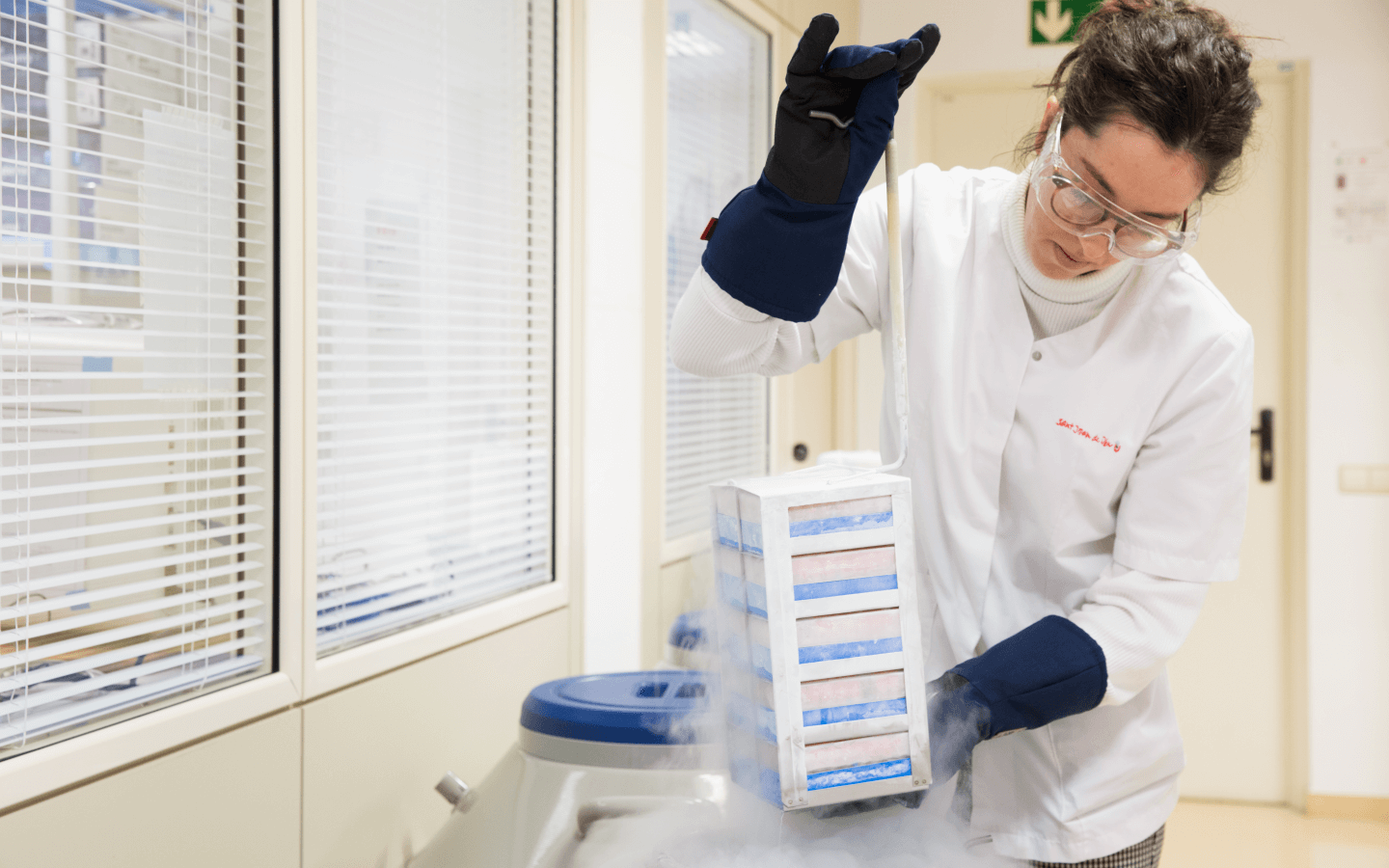Human Molecular Genetics II
Research Program
Leaders
Where we are
 Institut de Biomedicina de la UB (IBUB)
Institut de Biomedicina de la UB (IBUB)
Professional network profiles
Related websites
Our primary research ambition over the past few decades has been to identify new causative genes of paediatric/juvenile hereditary blindness, particularly inherited retinal diseases (IRD) and the functional analysis of these in vitro and in vivo in animal models.
Dr Gemma Marfany has recently co-founded a company for the diagnosis of genetic eye diseases (DBGen Ocular Genomics).
Over the years, the research team has generated and characterised models of retinal degeneration in cell cultures, as well as in zebrafish, mice (by gene editing) and in human iPSc-derived retinal organoids.
We are members of the Centre for Biomedical Network Research on Rare Diseases (CIBERER) and the Institute of Biomedicine of the University of Barcelona (IBUB). We are extremely active in disseminating science to the general public and maintaining close contact with patient associations.
Also, academically, we remain actively involved in training and mentoring of new researchers.
Research lines
- Genetic-molecular diagnosis by identifying IRD causative mutations by whole exome sequencing (WES) and candidate genes (target gene sequencing).
- Functional analysis of candidate genes, such as ATXN3 (associated with Machado-Joseph disease), NR2E3 (transcription factor required for photoreceptor differentiation) and CERKL (gene, with unknown function, discovered by our group) in cell and animal models. To accomplish this, we generated gene over-expression and silencing models in cultured cells and knockdown animals (zebrafish), in knockout mice using the Cre/loxP system and in mice models generated by CRISPR/Cas9 gene editing. We study the phenotype at electrophysiological, molecular and cellular levels.
- We also collaborate with other recognised research groups to generate organoids from patient- and control-derived iPSCs to study the molecular basis of blindness in a physiological model.
Scientific objectives
- To identify new genes implicated in hereditary dystrophies using whole-genome sequencing.
- To conduct research and design new approaches to improve genetic diagnosis in complex cases (detection of copy number variations, identification of deep intronic and promoter mutations, mitochondrial DNA analysis and heteroplasmy, etc.)
- To carry out the functional analysis of new genetic variants identified in the diseases we investigate.
- To establish the molecular basis of disease progression in organotypic mouse models and iPSc-derived organoids. To phenotype mice generated by different methodologies.
- To phenotype the retina of animal models using high-resolution microscopy.
- To explore, as a proof of concept of a possible gene therapy, the efficiency of gene transfer and phenotypic rescue in mouse retina using nanoparticles.
Area/Field of expertise
Our greatest accomplishment as a research group is the knowledge gained on the genetic and molecular causes of retinal degeneration in hereditary blindness. Our areas of specialisation are: 1) prioritising genetic variants after mass sequencing (WES and target gene sequencing) to identify mutations, and 2) conducting functional analysis of identified mutations in either cell or animal models. We have the capacity and know-how to conduct genetic transfection with gene silencing or over-expression, immunodetections, immunohistochemistry, co-immunoprecipitation, post-translational modifications and image analysis. We also use RNA extraction techniques and real-time quantitative RT-PCR expression analysis, alternative splicing analysis and deep-intronic mutation effects. We have experience in primary neuronal cultures and tissue explants, generation of transgenics in zebrafish embryos and temporary transgenics by subretinal microinjection in mouse retina.
Our specialisation focuses on the genetic and molecular biology of hereditary ocular diseases, specifically those that cause retinal neurodegeneration.
Group members
-

Jefe de Grupo Senior
-

Investigador post-doc

Last Publications
- Aísa-Marín I, Rovira Q, Díaz N, Calvo-López L, Vaquerizas JM and Marfany G Specific photoreceptor cell fate pathways are differentially altered in NR2E3-associated diseases NEUROBIOLOGY OF DISEASE . 194: 106463-106463.
- Baz-Redón N, Sánchez-Bellver L, Fernández-Cancio M, Rovira-Amigo S, Burgoyne T, Ranjit R, Aquino V, Toro-Barrios N, Carmona R, Polverino E, Cols M, Moreno-Galdó A, Camats-Tarruella N and Marfany G Primary Ciliary Dyskinesia and Retinitis Pigmentosa: Novel RPGR Variant and Possible Modifier Gene Cells . 13(6): .
- Izquierdo-Villalba I, Mirra S, Manso Y, Parcerisas A, Rubio J, Del Valle J, Gil-Bea FJ, Ulloa F, Herrero-Lorenzo M, Verdaguer E, Benincá C, Castro-Torres RD, Rebollo E, Marfany G, Auladell C, Navarro X, Enríquez JA, López de Munain A, Soriano E and Aragay AM A mammalian-specific Alex3/Gaq protein complex regulates mitochondrial trafficking, dendritic complexity, and neuronal survival SCIENCE SIGNALING . 17(822): 1007-1007.
Theses
-
CERKL as a modulator gene of mitochondrial dynamics and stress response in the retina
- Institution
- UNIVERSIDAD DE BARCELONA
-
Relevant deubiquitinating enzymes in cilium formation and function in the retina: USP48
- Institution
- UNIVERSIDAD DE BARCELONA
-
Exploring the role of NR2E3 in photoreceptor cell fate determination
- Author
- Aisa Marin, Izarbe
- Institution
- UNIVERSIDAD DE BARCELONA
News
-
Genetic mutations are identified as causing two types of hereditary blindness
The study led by Dr. Gemma Marfany describes how mutations in the NR2E3 gene lead to the death of photoreceptor cells involved in vision and pave the way for potential treatments.
-
This study identifies new functions in the gene that causes Machado-Joseph disease
The study, published in the journal Cell Reports, is led by Gemma Marfany, Human Molecular Genetics II · IRSJD, researcher at the Institute of Biomedicine of the UB (IBUB) and the CIBERER.
-
Researchers find new transposon-derived genes related to autism and other neurological diseases
Institut de Recerca Sant Joan de Déu researchers collaborate in this study led by Professor Jordi Garcia Fernàndez, from the Faculty of Biology and the Institute of Biomedicine of the University of Barcelona (IBUB).
More activities
-
Cátedra UB de Enfermedades Raras: Jornada sobre la Investigación
Aula de Graus. Facultat de Biologia. Universitat de Barcelona

 Universitat de Barcelona
Universitat de Barcelona  Institut de Biomedicina de la UB (IBUB)
Institut de Biomedicina de la UB (IBUB)